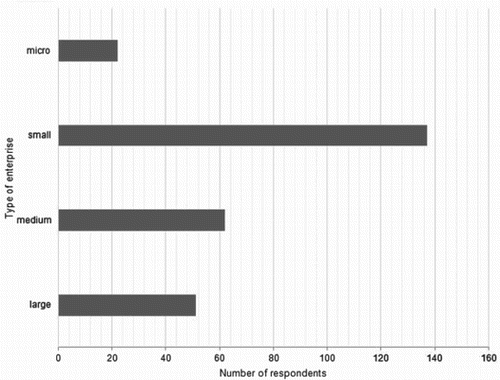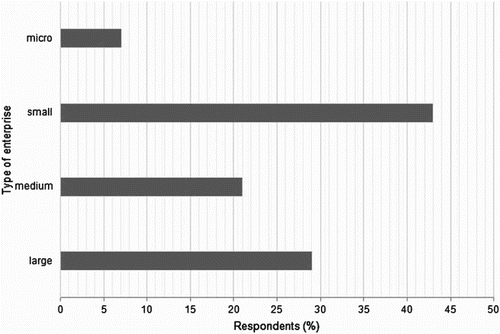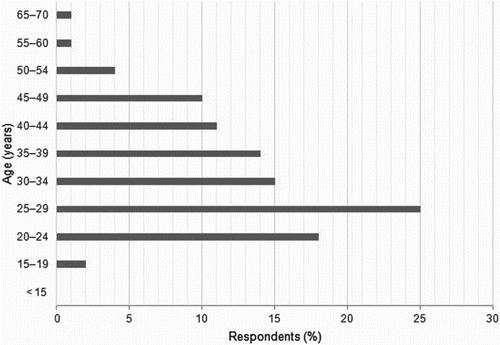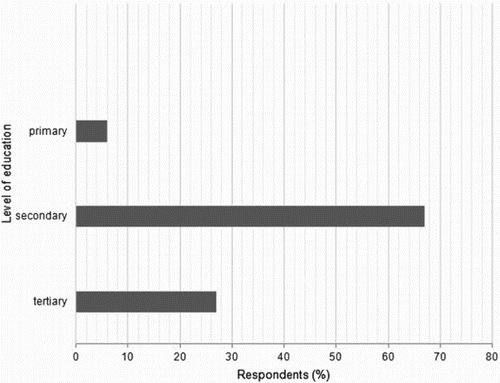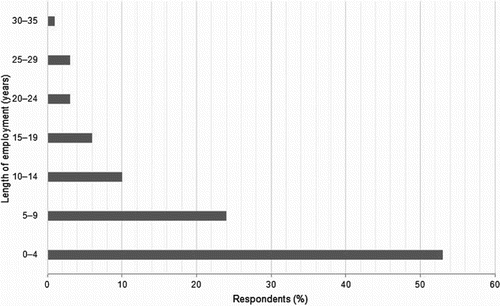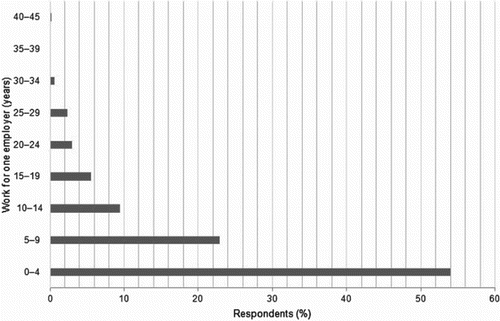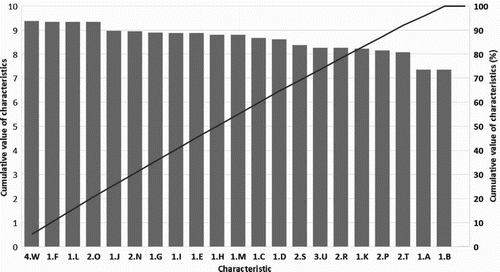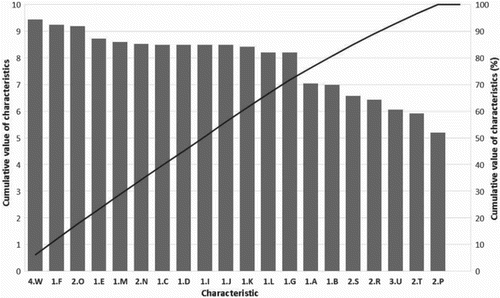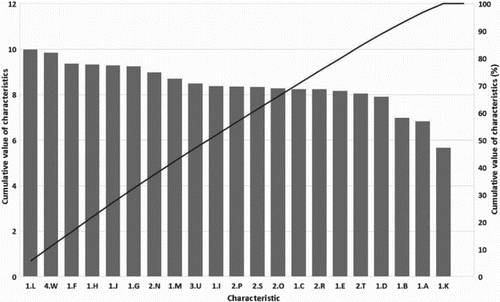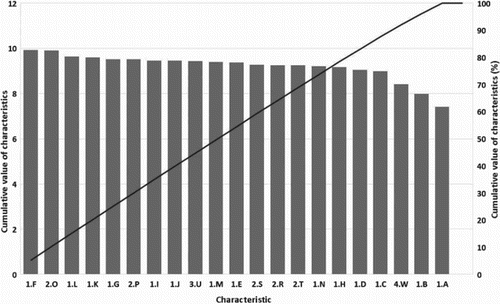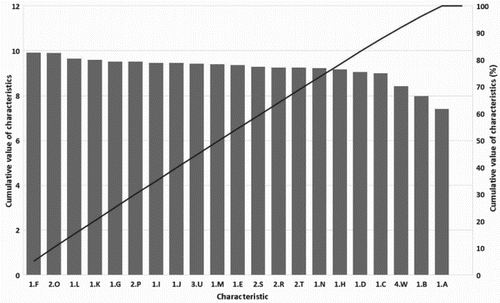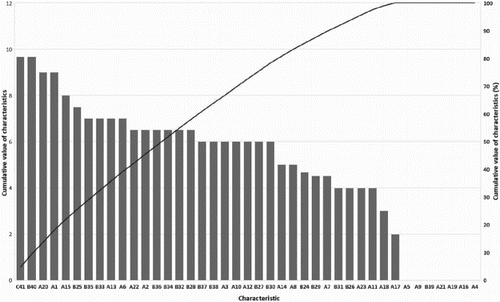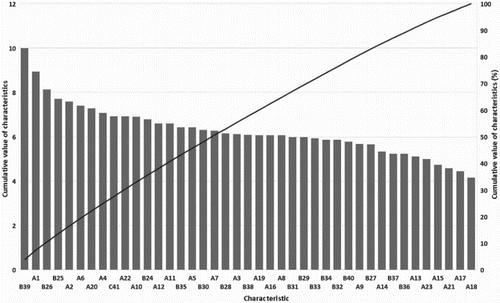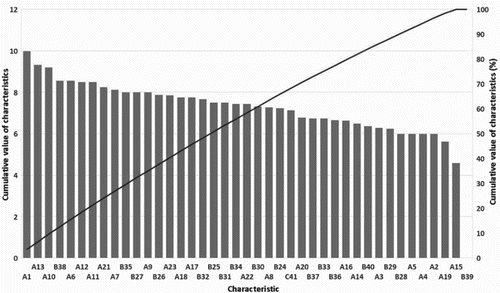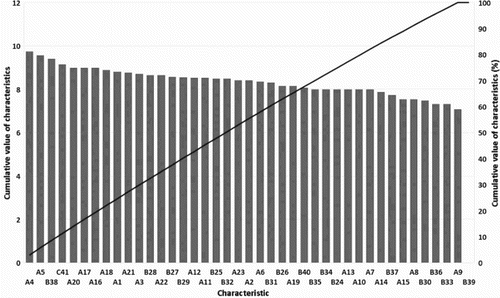Abstract
The construction industry is an important sector of the economy in Poland. According to the National Labour Inspectorate (PIP) data of 2014, the number of victims of fatal accidents in the construction sector amounted to 80 as compared with 187 injured in all other sectors of economy in Poland. This article presents the results of surveys on the impact of construction worker behaviour on the occupational safety and health outcomes. The surveys took into account the point of view of both construction site management (tactical level) and construction workers (operational level). For the analysis of results, the method of numerical taxonomy and Pareto charts was employed, which allowed the authors to identify the areas of occupational safety and health at both an operational and a tactical level, in which improvement actions needed to be proposed for workers employed in micro, small, medium and large construction enterprises.
1. Introduction
The construction industry is an important sector of the economy, which involves a significant proportion of employees globally. In the European Union it is considered a particularly hazardous sector. This is due to various significant hazards caused by, e.g., working at heights, in excavations or on traffic routes.
According to statistics from around the world, construction workers are three times more prone to fatal accidents and two times more prone to injuries as compared with workers employed in other economy sectors. According to European data, each year in the construction sector over 1000 workers are killed in accidents, and over 800,000 are injured [Citation1]. According to global data, each year 60,000 employees are killed in the construction industry worldwide. The construction sector employs 10% of workers globally, yet 20–40% of the total number of fatal accidents taking place in all economic sectors occur therein [Citation2].
According to the National Labour Inspectorate (PIP) data of 2014 [Citation3], the number of victims of fatal accidents in the construction sector amounted to 80 as compared with 187 injured in all other sectors of economy in Poland (Figure ).
Figure 1. Number of fatal accidents victims which occurred in Poland in 2014 and were investigated by the National Labour Inspectorate (PIP) [Citation3].
![Figure 1. Number of fatal accidents victims which occurred in Poland in 2014 and were investigated by the National Labour Inspectorate (PIP) [Citation3].](/cms/asset/295853cd-db17-41ca-bf40-594d08518163/tose_a_1375781_f0001_b.gif)
As such, the diagnosis of the state of occupational safety and health (OSH), taking account of the opinions of both interested construction company owners and their employees, is an important source of information on the causes of emerging hazards and the prevention thereof. Moreover, workers’ behaviour and their perception of matters on the construction site have a significant impact on the state of safety and health protection in the construction industry.
1.1. State of the art
An analysis of publications from recent years allows one to note the significance attributed by researchers to workers’ opinions, attitudes and behaviour on the construction site. To this end, methods involving surveys, interviews and accident analysis are employed.
There is a focus on the role for shaping the so-called culture of OSH, played by the so-called safety leadership of various participants in the construction process, such as owners of subcontracting companies or the general contractor's companies. However, this is of importance where proper communication between various organizational levels on the construction site is maintained [Citation2].
In order to create the right climate to ensure OSH, appropriate institutional pressure in this regard is required. The research on this issue was carried out using 186 questionnaires completed in various construction companies, which related to the application of coercive and legislative measures. These questionnaires indicated various ways in which institutions may contribute to facilitating the creation of the climate to improve the conditions of OSH within construction companies [Citation4].
Various research methods were also used to determine the factors impacting construction workers’ safety as well as their dangerous behaviour, including interviews and surveys. A statistical analysis of the research results helped to identify 14 such factors which were grouped into aspects of: the subjective perception of hazards, knowledge and experience, the specific nature of the executed work and safety management [Citation5].
In order to develop a safety strategy in construction companies, an analysis and selection of 221 safety practices applied in construction companies in Chile, which, according to the authors, may also be applied in other countries [Citation6], was also used.
What is also important to the improvement in occupational safety is analysis of the causes of accidents resulting from specific characteristics of the groups of emigrants working on the construction site. The method employed in this case involved interviews in the work environment, supported by appropriate photographic documentation. The article suggests that for groups of emigrants, the factors responsible for accidents include: (a) the time pressure combined with their inexperience gained in their home country; (b) assignment of more dangerous tasks to emigrants due to racism and discrimination; (c) willingness to accept an increased risk for fear of losing their job and, thus, an opportunity to support extended family; (d) unwillingness to express their opinion to superiors in fear of restrictions; (e) difficulties arising from family trouble; (f) difficulties with asking for help resulting from the so-called national pride [Citation7].
The surveys were also used to investigate the causes of injuries in students undertaking work in construction companies in Norway. With a high coefficient, it was found that the highest risk to students occurred in small construction companies, particularly those employing from 20 to 49 workers [Citation8].
Statistics of occupational accidents were also used for an analysis of the interdependencies of the risk of injury and the construction workers’ age and experience. It was found that in activities requiring specialized training, the number of injured among workers with a length of employment under 4 years was higher than in the work involving simple physical activities. The workers fraught with the highest risk are those with a length of employment under 4 years, within the age group of 20–34 years [Citation9].
Surveys were also used for investigating the state of safety in small construction companies. Selected important aspects of occupational safety in small Polish construction companies were also investigated, such as cooperation with the general contractor, OSH documentation, occupational risk assessment, organization of work, protective equipment and work equipment [Citation10].
In New Zealand, approximately 215 questionnaires were collected from workers attending safety training programmes at three different training centres. The programmes were provided by a national not-for-profit organization. Eight competing models were tested using structural equation modelling (SEM). They aimed to explore how safety climate factors positively affected safety behaviour. The developed integrative model suggests a combination of a safe organization, safe groups and safe workers’ strategies to reduce unsafe behaviour on construction sites [Citation11].
The results from a comprehensive analysis including surveys of 1018 apprentice carpenters and observational audits on 197 residential construction sites were used for fall prevention. This research supports growing evidence that worksite safety can be improved by training programmes geared towards boosting knowledge, changing attitudes and behaviours that affect construction falls [Citation12].
Interviews formed the basis for the analysis of safety leaders’ perceptions of safety culture in an Australasian large construction organization. The interviews followed a semi-structured format consisting of open-ended questions about various aspects of safety culture. The data collected from the interview responses helped to design and perform an online questionnaire [Citation13].
To ensure that work executed by subcontractors, namely small construction companies, is fraught with less risk and does not deteriorate accident statistics, it is necessary to take into account the specifics of the operation of such companies. There are many opportunities for gradual improvement of the unsatisfactory state of safety on construction sites. This, however, requires action on the part of all participants in the construction process, including general contractors, construction site managers, investors and OSH services. Reduction in occupational risk on site may also be the result of the activities of other institutions such as corporate training and OSH service providers [Citation14,Citation15].
Research also shows that further changes in legislation could also bring an improvement in the existing situation [Citation16,Citation17].
1.2. Research aims and hypotheses
The aim of the research was to identify the OSH status on construction sites in Poland for the purposes of diagnosis of the OSH status in the construction sector [Citation18].
The article presents the results of research on the impact of construction workers on the OSH status on the construction site. The research was to provide an answer to the following question: how does construction worker behaviour affect the level of OSH protection on construction sites?
The qualitative research performed focused on opinions on and attitudes towards the OSH protection on construction sites, and on the ways they are perceived and interpreted by, respectively:
construction site management (tactical level);
construction workers (operational level).
The research hypothesis was formulated as follows: OSH in the construction sector is influenced among other factors by both construction site managers’ and construction workers’ knowledge of rules and regulations as well as their behaviour.
2. Research method
The research was carried out among workers and construction site managers on randomly selected constructions underway in Poland.
For the research, the data were collected at construction sites. A site was regarded as an organization composed of people, machinery and materials used to erect a structure/execute construction works.
The research tool was a widely available survey. Construction workers completed surveys under the supervision of direct management, while respondents from the construction site management group completed them independently in their free time. The research covered respondents from two construction site management levels, namely the tactical level (construction site management/construction works management) and the operational level (construction workers). The aspects and issues included in the survey for the operational and tactical level are presented in Table .
Table 1. Aspects and issues for the operational and tactical levels included in the survey.
3. Range of the research method
3.1. Groups of respondents and their location
The research covered two groups of respondents – workers on construction sites located in Poland (Table ), employed in four categories of enterprises: micro, small, medium and large.
Table 2. Location of construction sites at which the research was carried out.
These respondents included:
300 construction workers who represented the operational level of the construction site (Figure );
50 construction site management staff from the tactical level, including management of contractors and subcontractors (Figure ).
3.2. Characteristics of respondents
Based on preliminary research, it was found that the respondents were employees of construction enterprises with a diverse age range (Figure ), mainly with secondary education (Figure ). Figures and present length of employment and period of work for one employer of respondents.
4. The research using a survey – the course and results
4.1. Stages of the research
The research was carried out in three stages:
(1) identification of knowledge and legal regulations concerning OSH in the polish construction sector;
(2) design of the research tool (survey), performance of research in construction enterprises and conducting survey research;
(3) compilation of questionnaire data and analysis of the research results, and preparation of a model of safety and health protection management.
4.2 Research results
The research results are presented in two groups:
construction workers (operational level);
construction site management/construction works management (tactical level).
At the operational level, the research covered 300 respondents, and the return rate of completed surveys was 91%. This means that 272 workers employed in construction companies participated in the research. They principally represented small companies employing from 10 to 49 workers. Nearly 1/4 of the workers included in the research were employed in medium enterprises, i.e., enterprises employing between 50 and 249 people, and nearly 20% were workers from large companies with the greater than or equal to 250 employees. In the research, the smallest group was workers employed in micro-enterprises with fewer than 10 employees.
The research participants were employed in enterprises representing a diverse type of business activities. More than half (60%) of respondents were employed in service companies, 1/3 of workers represented trade and service companies and the remaining 7% were employed in production companies.
The workers under research represented companies which varied in terms of legal status. Slightly more than half of the workers (51%) were employed in commercial enterprises. Slightly fewer, i.e., 42% of workers, represented employers engaged in individual business activity, while 7% of respondents worked in civil law companies.
During the research, issues of importance to safety and health protection in terms of the frequency of their occurrence at a particular workstation were assessed. In each area, questions concerning the areas of importance from the OSH protection were formulated, and codes of meaning were assigned to them. Respondents assigned numerical values 1–10 to their answers, where 1 = low level of fulfilment and 10 = high level of fulfilment (the assessment was based on subjective perceptions of the respondents). A summary of coded answers (mean values) concerning the issues of particular aspects, broken down by the size of enterprise in which respondents were employed, is presented in Table .
Table 3. Summary of coded answers concerning the issues of the operational level in particular areas, broken down by size of the enterprise.
At the tactical level, 50 respondents, namely representatives of construction site management, were included in the research. They were mainly employees of small (43%) and medium (21%) enterprises engaged principally in service functions (50%). The survey focused on the assessment of factors determining the effectiveness and efficiency of actions taken by construction site management in the field of safety and health protection, and the assessment of construction site manager/construction works manager knowledge of OSH protection.
Similarly to the research at the operational level of the construction site, in each area of the research at the tactical level questions concerning the issues of importance from the OSH protection were formulated, and codes of meaning were assigned to them. Respondents assigned numerical values 1–10 to their answers, where 1 = low level of fulfilment and 10 = high level of fulfilment (the assessment was based on subjective perceptions of the respondents).
A summary of coded answers (mean values) concerning the issues in particular areas, broken down by the size of enterprise in which respondents were employed, is presented in Table .
Table 4. Summary of coded answers concerning issues at a tactical level in particular areas, broken down by size of the enterprise.
5. Research results discussion
The analysis of research results employed numerical taxonomy methods. To this end, the following terms were specified:
objects – elements belonging to the OSH set, investigated in terms of OSH;
characteristics – the investigated properties of OSH.
The external image of results of the research on construction workers was numerical values presented in the form of a layout of data sets. One set consisted of objects (a set of objects), while the characteristics assigned to these objects were a set of characteristics.
The results of the discussion were based on the Pareto principle, which made it possible to identify the key factors influencing the OSH level. A Pareto chart is a vertical bar graph in which values are plotted in decreasing order (from left to right). Pareto charts are very useful for analysing which problems need attention first, because the taller bars on the chart clearly illustrate which variables have the greatest cumulative effect on a given system. The Pareto chart provides a graphic depiction of the Pareto principle, a theory maintaining that 80% of the output in a given situation or system is produced by 20% of the input.
A discussion of the results was carried out on two levels: operational and tactical. In the discussion:
aggregate areas of the operational level (Table ) and the tactical level (Table ) were compiled;
these areas were arranged in ascending order by the values of the characteristics;
cumulative values were calculated;
the cumulative values were converted into percentages in the overall value for a characteristic;
Pareto charts were developed for:
the operational level, including the overall situation (Figure ), small enterprises (Figure ), micro-enterprises (Figure ), large enterprises (Figure ) and medium enterprises (Figure );
the tactical level, including micro-enterprises (Figure ), small enterprises (Figure ), medium enterprises (Figure ) and large enterprises (Figure ).
At the general operational level (mean values presented in Table 3), the respondents distinguished the aspects of preparation and organization of construction, including: the construction site; sanitary facilities; harmful, burdensome and dangerous factors; OSH training.
With regards to small enterprises at the operational level, the respondents indicated the aspects concerning workers executing construction works in the following fields: OSH training; harmful, burdensome and dangerous factors; personal protection equipment; risks at workstations.
Employees of micro-enterprises at the operational level highlighted the aspects of safety and health protection requirements for concreting and reinforced concreting works, and the aspects concerning the preparation and organization of construction, including: the construction site; sanitary facilities; storage of materials; burdensome, harmful and dangerous factors occurring on the construction site.
Employees of large enterprises at the operational level also indicated the aspects of the preparation and organization of construction, including: the construction site; sanitary facilities; electrical power equipment on site.
Employees of medium enterprises at the operational level drew attention to the aspects of the preparation and organization of construction, in particular: sanitary facilities; the construction site; OSH concerning construction works (finishing and transport works).
Employees of micro-enterprises at the tactical level drew attention to the aspects of effectiveness and efficiency of actions taken by construction site managers, primarily in the following areas: responsible person for OSH; the policy; internal communication; inspection, monitoring and prevention of hazards to OSH on site.
Employees of small enterprises at the tactical level highlighted the aspects of effectiveness and efficiency of actions taken by construction site managers in the following areas: prevention of hazards; audits; coordination of activities in the field of OSH; assessment of subcontractors; changes to the safety and health protection plan resulting from the progress of works.
Employees of medium enterprises at the tactical level indicated other categories of construction site manager knowledge concerning primarily: coordination of actions in the event of a hazard; assessment of subcontractors; OSH inspections on site.
Employees of large enterprises at the tactical level highlighted the aspects of manager knowledge of OSH – including those concerning: costs; results of OSH assessment on sites; consequences of failure to meet requirements for OSH – as well as the aspects of effectiveness and efficiency of actions taken by construction site managers regarding internal communication and the assessment of subcontractors in terms of OSH.
6. Conclusion
The presented Pareto chart research results are based on mean values related to respondents’ opinions and their perception and interpretation of OSH. This is an attempt to set in order these issues and to identify trends in this area. In the case of repeating these studies, detailed analysis will be possible, including statistical methods.
The applied research method also has its limitations. Construction companies employing respondents were located in north-eastern Poland. Therefore, the research did not cover the entire country. Moreover, most respondents were operational-level employees (construction workers). The application of the numerical taxonomy and the Pareto principle to analyse the research results allowed the authors to identify subjective perceptions of employees and management regarding the important aspects of OSH. However, opinions of the respondents directly involved in the construction process may be the basis to point out areas for improving OSH at both the operational and tactical levels of the construction site.
At the operational level of the construction site, the following must be done by the construction site management group in the following order:
provide workers employed in small enterprises with OSH training;
monitor construction works, including concreting and reinforced concreting works executed by employees of micro-enterprises;
inspect the construction site for OSH/works executed by employees of large enterprises;
check the sanitary facilities for employees of medium enterprises.
When providing employees of small enterprises with OSH training, special attention must be paid to compliance with OSH provisions and rules during the execution of construction works by broadening the general instruction, periodic training and familiarization with hazards which may occur during the execution of works. What is also important is to explain the meaning of harmful, burdensome and dangerous factors at workstations, when discussing working and protection clothing, and informing workers of occupational risks.
During the monitoring of concreting and reinforced concreting works executed by employees of micro-enterprises, attention must be paid to the following:
preparation and organization of works, including staying within the pump danger zone and the use of bump rails of truck mixers while pouring concrete mix;
the area of execution of works, including the place for storage of materials, parking spaces for construction equipment and protection of works against unauthorized persons.
When inspecting the construction site for OSH/works executed by employees of large enterprises, the following must be borne in mind:
preparation and organization of works, including storage spaces for construction vehicles, pedestrian traffic and storage of materials;
sanitary facilities, including sanitary rooms.
While checking sanitary facilities for employees of medium enterprises, the following are of importance: sanitary rooms; walkways on the construction site; parking spaces for construction vehicles; storage of construction materials.
At the tactical level of the construction site, actions must be initiated by the construction site management group in the following order with construction site managers:
micro-enterprises in the following areas:
responsible person for safety and health protection on site;
safety and health protection policy in writing;
external OSH communication;
monitoring, inspections, audits and coordination of OSH on site;
occupational risk assessment;
changes to information on OSH and the OSH plan, resulting from the progress of works on site;
small enterprises in the following areas:
prevention and coordination measures in the event of a hazard;
assessment of subcontractors regarding OSH;
changes to information on OSH and the OSH plan, resulting from the progress of works on site;
prevention of accidents;
analysis of results of external inspections, audits and check-ups regarding OSH;
safety of construction materials;
corrective actions and measures preventing haz-ards;
external communication;
medium enterprises in the following areas:
assessment of subcontractors regarding OSH;
OSH inspections on site;
specified safety and health protection policy and aims, and plans for achieving them;
safety of construction materials;
monitoring OSH on site;
large enterprises in the following areas:
external OSH communication on site;
costs of OSH on site;
results of the assessment of OSH on particular sites;
consequences to health and life, resulting from hazards;
results of audits and internal inspections;
safety of construction materials;
OSH procedures and training programmes on site.
The research results show that both construction site managers’ and construction workers’ knowledge of rules and regulations as well as their behaviour affects OSH significantly in small, medium and large enterprises.
Disclosure statement
No potential conflict of interest was reported by the authors.
References
- European Agency for Safety and Health at Work. Construction safety risks and prevention [Internet]. Bilbao: EU-OSHA; 2016 [cited 2016 Jun 22]. Available from: https://oshwiki.eu/wiki/Construction_safety*The_construction_sector_in_Europe
- Wu C, Wang F, Zou PXW, et al. How safety leadership works among owners, contractors and subcontractors in construction projects. Int J Proj Manage. 2016;34(5):789–805. doi:doi: 10.1016/j.ijproman.2016.02.013
- Główny Inspektor Pracy [Chief Labour Inspector]. Sprawozdanie z działalności Państwowej Inspekcji Pracy w 2014 [Report on the activities of the National Labour Inspectorate in 2014]. Warszawa: Państwowa Inspekcja Pracy; 2015 [cited 2016 July 22]. Available from: https://www.pip.gov.pl/pl/f/v/133794/sprawozdanie%202014.pdf*page=13. Polish.
- He Q, Dong S, Rose T, et al. Systematic impact of institutional pressures on safety climate in the construction industry. Accid Anal Prev. 2016;93:230–239. doi:doi: 10.1016/j.aap.2015.11.034
- Wang J, Zou PXW, Li PP. Critical factors and paths influencing construction workers’ safety risk tolerances. Accid Anal Prev. 2016;93(Aug):267–279. doi: 10.1016/j.aap.2015.11.027
- Alarcón LF, Acuña D, Diethelm S, et al. Strategies for improving safety performance in construction firms. Accid Anal Prev. 2016;94(Sep):107–118. doi:doi: 10.1016/j.aap.2015.11.027
- Hallowell MR, Yugar-Arias IF. Exploring fundamental causes of safety challenges faced by Hispanic construction workers in the US using photovoice. Saf Sci. 2016;82(Feb):199–211. doi:doi: 10.1016/j.ssci.2015.09.010
- Holte KA, Kjestveit K, Lipscomb HJ. Company size and differences in injury prevalence among apprentices in building and construction in Norway. Saf Sci. 2015;71(Part C, Feb):205–212. doi:doi: 10.1016/j.ssci.2014.01.007
- Mučenski V, Peško I, Dražić J, et al. Construction workers injury risk assessment in relation to their experience and age. Procedia Eng. 2015;117:525–533. doi:doi: 10.1016/j.proeng.2015.08.205
- Dąbrowski A. An investigation and analysis of safety issues in Polish small construction plants. Int J Occup Saf Ergon. 2015;21(4):498–511. doi:doi: 10.1080/10803548.2015.1085206
- Guo BHW, Yiu TW, Gonzales VA. Predicting safety behavior in the construction industry: development and test of an integrative model. Saf Sci. 2016;84(Apr):1–11. doi:doi: 10.1016/j.ssci.2015.11.020
- Evanoff B, Dale AM, Zeringue A, et al. Results of a fall prevention educational intervention for residential construction. Saf Sci. 2016;89(Nov):301–307. doi:doi: 10.1016/j.ssci.2016.06.019
- Biggs SE, Banks TD, Davey JD, et al. Safety leaders’ perceptions of safety culture in a large Australasian construction organisation. Saf Sci. 2013;52(Feb):3–12. doi:doi: 10.1016/j.ssci.2012.04.012
- Obolewicz J. Zarządzanie bezpieczeństwem pracy w budownictwie [Management of safety of work in construction]. Przedsiębiorczość i Zarządzanie. 2014;15(6, Pt 1):441–451. Polish.
- Obolewicz J. Bezpieczeństwo i ochrona zdrowia w budowlanym procesie inwestycyjnym [Safety and health protection in construction investment process]. In: Błazik-Borowa E, Czarnocki K, Dąbrowski A, et al., editors. Bezpieczeństwo pracy w budownictwie [Occupational safety in construction]. Lublin: Lublin University of Technology; 2015. p. 51–60. Polish.
- Dąbrowski A. National Programme. Poprawa bezpieczeńs-twa i warunków pracy [Improvement of safety and work condition]. Zadanie 04.A.24 [Task 04.A.24]. Zasady doboru środków prewencji metodą analiz stanowisk pracy w celu ograniczania zagrożeń urazowych w małych polskich przedsiębiorstwach budowlanych [Rules for selection of prevention measures using the method of analysis of workstations to reduce injury hazards in small Polish construction enterprises]. Warszawa: CIOP-PIB; 2010. (Unpublished report). Polish.
- Obolewicz J. Legal and administrative framework for health and safety assessment in the construction sector after Poland’s accession to the European Union. Actual Probl Econ. 2013;12:447–456.
- Obolewicz J. Identyfikacja stanu bezpieczeństwa i ochrony zdrowia w polskich przedsiębiorstwach budowlanych po wejściu do UE i zaprojektowanie modelu zarządzania bioz spełniającego europejskie kryteria jakościowe, ochrony środowiska, ergonomii i ochrony pracy [Identification of the state of safety and health protection in Polish construction enterprises after entering the EU and design of OSH management model complying with environmental protection, ergonomics and labour protection European quality criteria]. Białystok: Białystok University of Technology; 2014. (Unpublished research report No. N N115347038). Polish.

